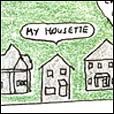|
amy storrowSEE Amy's self-drawn map of her neighborhood. READ Edward Hirsch's poem, "Work Song," set in Doville. READ Rosellen Brown's essay "On Leaving Texas" about having to leave her Doville home. Amy's neighborhood, Doville, is located in the larger area of Houston known as Montrose. Like most of Houston (which is famous for its lack of zoning laws) Montrose is an eclectic mix of gourmet markets, ice-houses, bodegas, small businesses, stately old houses, multi-family dwellings and brand new townhouses. In the 70s and 80s the neighborhood was sometimes referred to as the zona rosa for its gay-friendly atmosphere. Montrose is home to Doville and therefore many artists and lovers of the arts as well as many students at Rice University and the University of Houston. The name "Doville" is a triple pun-"Do" as in "Dominique de Menil"; "Do" as in "Deauville," the resort town in Normandy; and "Do" as in "dough," moolah. Almost everything in Doville that might seem to have one explanation usually has at least three. Those who concern themselves with such details are interested in "Menilia." It all began with the founding of the University of St. Thomas in Houston shortly after the de Menils had emigrated from France. The de Menils offered the Basilian fathers a master plan to be designed by architect Philip Johnson; he finished the plan in 1957. The de Menils were deeply involved with the school. Dominique de Menil chaired the art history department, where she taught classes using art from the collection itself rather than with slides. Dominique de Menil, a member of the Schlumberger family-a dynasty of intellectuals and inventors, and the founders of Schlumberger, Ltd.--held an advanced degree in physics. She once said that one couldn't understand art unless one also understood physics. In February 1964, the de Menils' close friend and mentor, the distinguished museum curator Jermayne MacAgy, died suddenly. Dominique de Menil said, "When the floor collapses, it's time for an act of faith." The Rothko Chapel, commissioned in 1969, was the result. It came to be built on land adjacent to the University of St. Thomas campus. Meanwhile, the de Menils had started quietly buying up the bungalows to its west. They were painted gray in 1974. While Philip Johnson worked with Mark Rothko in designing the chapel, the project was completed by architects Howard Barnstone and Eugene Aubry in 1971. The bungalows' color is called "Howard gray" because Barnstone came up with its shade. Dominique de Menil knew that the gray would work particularly well to set off the lush green of Houston's subtropical landscape. Dominique de Menil wanted to encourage artists, writers, and musicians to live in Doville (as well as families with children), and she understood that low rent would underwrite creative endeavor, so "special cases" got special rents. The Menil Collection itself, the jewel in the crown, was completed in 1987. Its gray cedar siding recalls that of the bungalows. Contents Copyright 2001, National Public Radio |
||||||||||



